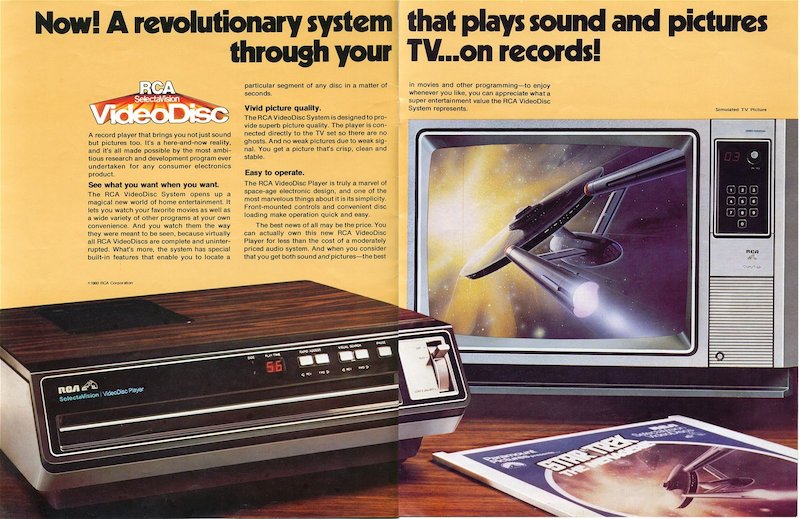Capacitance Electronic Disks are one of the great disasters in the history of video storage systems, and are pretty much unknown today.
CEDs themselves are much like traditional vinyl phonograph records, but with the grooves much, much finer. The data storage density is about two orders of magnitude greater than for a phonograph, but the mechanism is the same… extremely fine spiral grooves pressed into the platter. And like a phonograph, the data was picked up from the disk via a physical stylus. However, the way the stylus worked was completely different. A phonograph stylus rode in the groove and picked up the side-to-side and up-and-down variations in the groove, using small magnets to convert that movement into electrical signals. The CED system had smooth spiral groves but with variations in the depth; the stylus was not a needle, but more like a boat keel. As the name suggested, the capacitance electronic disks used the difference in capacitance between the bottom of the stylus and the variable depth of the groove. The platters were made from vinyl heavily loaded with carbon to make them electrically conductive. The data was analog, not digital.
The technology was first developed by RCA in the 1960’s, but due to various issues was not commercialized (as “SelectaVision” and “VideoDisc” until 1981. And that’s what doomed it… by that time videotape systems like VHS and Betamax were already on the market. The CED’s gave about an hour of video per side of the disk, meaning the average movie would require flipping the disk, and many would require multiple disks. The video quality was approximately like that available on videotape. The advantage CEDs provided was that both the disks and the players were cheaper than video tapes (the same presses that stamped out traditional vinyl records could stamp out CEDs). But this slight advantage didn’t counteract the disadvantages… dust would cause the system to skip, you couldn’t record on it, it was cumbersome to deal with, etc. The last CED movie was released in 1986. In the end RCA lost $600 million on the project.
CEDs were, apart from cost, wholly without merit at just the moment they were released. LaserDiscs, the predecessors of DVDs, were released a few years prior to CEDs, and provided not only much superior image quality, but also pointed the way towards the future. The CED was “retro” before it was released.
It’s that latter aspect that makes me wonder if we’ll see a revival of CEDs. Their very “retro” nature makes them seem like the perfect hipster video system. If someone could come up with a way to make a recordable CED they might be onto something. It doesn’t seem like it should be too difficult… produce a blank disk with smooth grooves stamped in it, and provide the recorder with a laser powerful and precise enough to blast the variable topography into the bottom of the groove. Roughly similar to the system used in recordable CDs and DVDs, but with the added headache of vaporized carbon-loaded vinyl to deal with right next to a precise optical system.
A good page describing the system is HERE. There are a bunch of YouTube videos from back in the day, including this one. Note: this is like someone boiled down the early 1980’s into a thick slurry for intravenous injection. Also, a “trigger warning:” Jane Fonda.
If the first minute of this video abomination doesn’t make you laugh… then you didn’t live through the early 80’s.
If someone who had never heard of CEDs were to find one today and be tasked with decoding one, I have doubts that they would come up with the actual intended system. Instead, an optical reader would probably be used, using a laser system chopped from a CD player; or perhaps they’d risk running a physical stylus over the bottoms of the grooves. Who would think to use variable capacitance as a reading system?
And this, of course, was a technology developed within a human lifetime ago, by humans, for humans. Now imagine that an utterly alien data storage system fell into our hands. Would we be able to read it? Would we be able to read it *once,* destroying it in the process?
